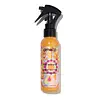What's inside
What's inside
 Key Ingredients
Key Ingredients

 Benefits
Benefits

 Concerns
Concerns

 Ingredients Side-by-side
Ingredients Side-by-side

Water
Skin ConditioningCetearyl Alcohol
EmollientIsopropyl Palmitate
EmollientCapryloyl Glycerin/Sebacic Acid Copolymer
Skin ConditioningBehentrimonium Chloride
PreservativeDiheptyl Succinate
EmollientQuaternium-91
Persea Gratissima Oil
Skin ConditioningSqualane
EmollientHippophae Rhamnoides Fruit/Seed Oil
AntimicrobialBrassica Campestris Seed Oil
Skin ConditioningSesamum Indicum Seed Oil
EmollientCocos Nucifera Oil
MaskingSodium Hyaluronate
HumectantPolyglutamic Acid
Skin ConditioningSpirulina Platensis Extract
Skin ProtectingCocos Nucifera Water
MaskingEmblica Officinalis Fruit Extract
Skin ConditioningCurcuma Longa Root Extract
MaskingButyrospermum Parkii Butter
Skin ConditioningLeuconostoc/Radish Root Ferment Filtrate
AntimicrobialGlycerin
HumectantBehentrimonium Methosulfate
PPG-3 Benzyl Ether Myristate
EmollientGuar Hydroxypropyltrimonium Chloride
Skin ConditioningPolyquaternium-37
Polyquaternium-73
Propylene Glycol Dicaprylate/Dicaprate
EmollientPolyquaternium-7
Ethylhexylglycerin
Skin ConditioningTetrasodium Glutamate Diacetate
PPG-1 Trideceth-6
Skin ConditioningSodium Hydroxide
BufferingSodium Chloride
MaskingIsopropyl Alcohol
SolventCitric Acid
BufferingPotassium Sorbate
PreservativeSodium Benzoate
MaskingPhenoxyethanol
PreservativeParfum
MaskingBenzyl Benzoate
AntimicrobialHydroxycitronellal
PerfumingLimonene
PerfumingWater, Cetearyl Alcohol, Isopropyl Palmitate, Capryloyl Glycerin/Sebacic Acid Copolymer, Behentrimonium Chloride, Diheptyl Succinate, Quaternium-91, Persea Gratissima Oil, Squalane, Hippophae Rhamnoides Fruit/Seed Oil, Brassica Campestris Seed Oil, Sesamum Indicum Seed Oil, Cocos Nucifera Oil, Sodium Hyaluronate, Polyglutamic Acid, Spirulina Platensis Extract, Cocos Nucifera Water, Emblica Officinalis Fruit Extract, Curcuma Longa Root Extract, Butyrospermum Parkii Butter, Leuconostoc/Radish Root Ferment Filtrate, Glycerin, Behentrimonium Methosulfate, PPG-3 Benzyl Ether Myristate, Guar Hydroxypropyltrimonium Chloride, Polyquaternium-37, Polyquaternium-73, Propylene Glycol Dicaprylate/Dicaprate, Polyquaternium-7, Ethylhexylglycerin, Tetrasodium Glutamate Diacetate, PPG-1 Trideceth-6, Sodium Hydroxide, Sodium Chloride, Isopropyl Alcohol, Citric Acid, Potassium Sorbate, Sodium Benzoate, Phenoxyethanol, Parfum, Benzyl Benzoate, Hydroxycitronellal, Limonene
 Reviews
Reviews

Alternatives
Ingredients Explained
These ingredients are found in both products.
Ingredients higher up in an ingredient list are typically present in a larger amount.
Benzyl Benzoate is usually created from the condensation of benzoic acid and benzyl alcohol. It is used as a preservative, solvent, and has a floral/balsamic scent in large amounts.
As a preservative, Benzyl Benzoate works against bacteria and fungus. It is often used to treat scabies and lice in medicine.
Solvents are used to keep ingredients together in a product. They can help dissolve ingredients to stable bases or help evenly distribute ingredients throughout the product.
Due to its fragrance, Benzyl Benzoate can be sensitizing and may cause contact dermatitis. It is a known EU allergen. We recommend speaking with a professional if you have any concerns.
Benzyl Benzoate can be naturally found in cranberries and peaches.
Learn more about Benzyl BenzoateHippophae Rhamnoides Fruit/Seed Oil comes from the seabuckthorn plant. It is rich in tocopherols, tocotrienols, and plant sterols.
This oil is rich in fatty acids, including: two types of linoleic acid (~30-34%), oleic acid (17%), and palmiteic acid (35%). Note these numbers are averages, and different parts of the plant will vary.
Palmitoleic acid has been shown to help soothe inflammation and promote wound healing. It is also naturally found in the fat of our skin.
Learn more about Hippophae Rhamnoides Fruit/Seed OilHydroxycitronellal is a fragrance created from citronellal. The smell of hydroxycitronellal is often described as "citrus-like" or "melon-like".
Hydroxycitronellal is a known EU allergen and may cause irritation when applied to the skin.
Limonene is a fragrance that adds scent and taste to a formulation.
It's found in the peel oil of citrus fruits and other plants such as lavender and eucalyptus. The scent of limonene is generally described as "sweet citrus".
Limonene acts as an antioxidant, meaning it helps neutralize free radicals.
When exposed to air, oxidized limonene may sensitize the skin. Because of this, limonene is often avoided by people with sensitive skin.
The term 'fragrance' is not regulated in many countries. In many cases, it is up to the brand to define this term. For instance, many brands choose to label themselves as "fragrance-free" because they are not using synthetic fragrances. However, their products may still contain ingredients such as essential oils that are considered a fragrance.
Learn more about LimoneneParfum is a catch-all term for an ingredient or more that is used to give a scent to products.
Also called "fragrance", this ingredient can be a blend of hundreds of chemicals or plant oils. This means every product with "fragrance" or "parfum" in the ingredients list is a different mixture.
For instance, Habanolide is a proprietary trade name for a specific aroma chemical. When used as a fragrance ingredient in cosmetics, most aroma chemicals fall under the broad labeling category of “FRAGRANCE” or “PARFUM” according to EU and US regulations.
The term 'parfum' or 'fragrance' is not regulated in many countries. In many cases, it is up to the brand to define this term.
For instance, many brands choose to label themselves as "fragrance-free" because they are not using synthetic fragrances. However, their products may still contain ingredients such as essential oils that are considered a fragrance by INCI standards.
One example is Calendula flower extract. Calendula is an essential oil that still imparts a scent or 'fragrance'.
Depending on the blend, the ingredients in the mixture can cause allergies and sensitivities on the skin. Some ingredients that are known EU allergens include linalool and citronellol.
Parfum can also be used to mask or cover an unpleasant scent.
The bottom line is: not all fragrances/parfum/ingredients are created equally. If you are worried about fragrances, we recommend taking a closer look at an ingredient. And of course, we always recommend speaking with a professional.
Learn more about ParfumPersea Gratissima Oil is also known as avocado oil.
Avocado Oil has antioxidant properties. It is mostly made up of the glycerides of fatty acids. About 67% of these fatty acids is made up of oleic acid. Palmitic acid and linoleic acid are also present.
These fatty acids help hydrate and soften the skin. It may increase collagen content in the skin. Collagen helps keep your skin plump and firm. This ingredient helps reduce inflammation and has not shown to clog pores.
This ingredient may not be fungal-acne safe due to its high fatty acid content.
Avocados also have B vitamins, vitamin K, vitamin C, vitamin E, and potassium.
Learn more about Persea Gratissima Oil